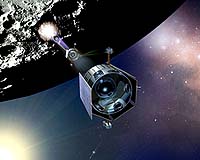 |
Greenbelt, MD (SPX) Jun 23, 2009 After a four and a half day journey from the Earth, the Lunar Reconnaissance Orbiter, or LRO, has successfully entered orbit around the moon. Engineers at NASA's Goddard Space Flight Center in Greenbelt, Md., confirmed the spacecraft's lunar orbit insertion at 6:27 a.m. EDT Tuesday. During transit to the moon, engineers performed a mid-course correction to get the spacecraft in the proper position to reach its lunar destination. Since the moon is always moving, the spacecraft shot for a target point ahead of the moon. When close to the moon, LRO used its rocket motor to slow down until the gravity of the moon caught the spacecraft in lunar orbit. "Lunar orbit insertion is a crucial milestone for the mission," said Cathy Peddie, LRO deputy project manager at Goddard. "The LRO mission cannot begin until the moon captures us. Once we enter the moon's orbit, we can begin to buildup the dataset needed to understand in greater detail the lunar topography, features and resources. We are so proud to be a part of this exciting mission and NASA's planned return to the moon." A series of four engine burns over the next four days will put the satellite into its commissioning phase orbit. During the commissioning phase each of its seven instruments is checked out and brought online. The commissioning phase will end approximately 60 days after launch, when LRO will use its engines to transition to its primary mission orbit. For its primary mission, LRO will orbit above the moon at about 31 miles, or 50 kilometers, for one year. The spacecraft's instruments will help scientists compile high resolution, three-dimensional maps of the lunar surface and also survey it at many spectral wavelengths. The satellite will explore the moon's deepest craters, examining permanently sunlit and shadowed regions, and provide understanding of the effects of lunar radiation on humans. LRO will return more data about the moon than any previous mission.
earlier related report After a four and a half day journey to the moon, NASA's Lunar Reconnaissance Orbiter, or LRO, will be captured by the moon's gravity and prepare for the commissioning phase of its mission on June 23. NASA TV live coverage of LRO's orbit insertion begins at 5:30 a.m. EDT Tuesday, with the actual engine burn to begin orbit insertion starting at 5:47 a.m. In addition to animation and footage of LRO, live interviews will be broadcast from NASA's Goddard Space Flight Center in Greenbelt, Md., with Cathy Peddie, LRO deputy project manager at Goddard; Jim Garvin, Goddard chief scientist; Laurie Leshin, Goddard deputy director for Science and Technology; Mike Wargo, NASA's chief lunar scientist in the Exploration Systems Mission Directorate at NASA Headquarters in Washington; Rich Vondrak, LRO project scientist at Goddard; and Craig Tooley, LRO project manager at Goddard. At 8:20 a.m. Tuesday, the Science Operations Center at NASA's Ames Research Center in Moffett Field, Calif., will stream live telemetry-based spacecraft animation and the visible camera images from the Lunar Crater Observation and Sensing Satellite, or LCROSS, spacecraft as it swings by the moon before entering into a looping polar Earth orbit. Live video streaming via the Internet will last approximately one hour. The LCROSS swingby starts near the lunar south pole and continues north along the far side of the moon. The maneuver will put the LCROSS spacecraft and its spent second stage Centaur rocket in the correct flight path for the October impact near the lunar south pole. The swingby also will give the mission operations team the opportunity to practice the small trajectory correction maneuvers needed to target the permanently shadowed crater that will be selected by the LCROSS science team. During the swingby, the science team will make measurements of the moon's surface and the lunar horizon to calibrate the spacecraft's cameras and spectrometers. The LCROSS visible spectrometer will make the first near-ultraviolet survey of the selected locations on the far-side of the moon giving scientists a unique look at the concentration of minerals and elements in the lunar soil. LCROSS and its attached Centaur upper stage rocket separately will collide with the moon the morning of Oct. 9, 2009, creating a pair of debris plumes that will be analyzed for the presence of water ice or water vapor, hydrocarbons and hydrated materials. Share This Article With Planet Earth
Related Links LRO at NASA Mars News and Information at MarsDaily.com Lunar Dreams and more
 New NASA Missions To Reach Moon Tuesday
New NASA Missions To Reach Moon TuesdayWashington DC (SPX) Jun 23, 2009 Two NASA spacecraft will reach major mission milestones early Tuesday morning as they approach the moon - one will send back live streaming imagery via the Internet as it swings by the moon, the other will insert itself into lunar orbit to begin mapping the moon's surface. After a four and a half day journey to the moon, NASA's Lunar Reconnaissance Orbiter, or LRO, will be captured by the ... read more |
|
| The content herein, unless otherwise known to be public domain, are Copyright 1995-2009 - SpaceDaily. AFP and UPI Wire Stories are copyright Agence France-Presse and United Press International. ESA Portal Reports are copyright European Space Agency. All NASA sourced material is public domain. Additional copyrights may apply in whole or part to other bona fide parties. Advertising does not imply endorsement,agreement or approval of any opinions, statements or information provided by SpaceDaily on any Web page published or hosted by SpaceDaily. Privacy Statement |